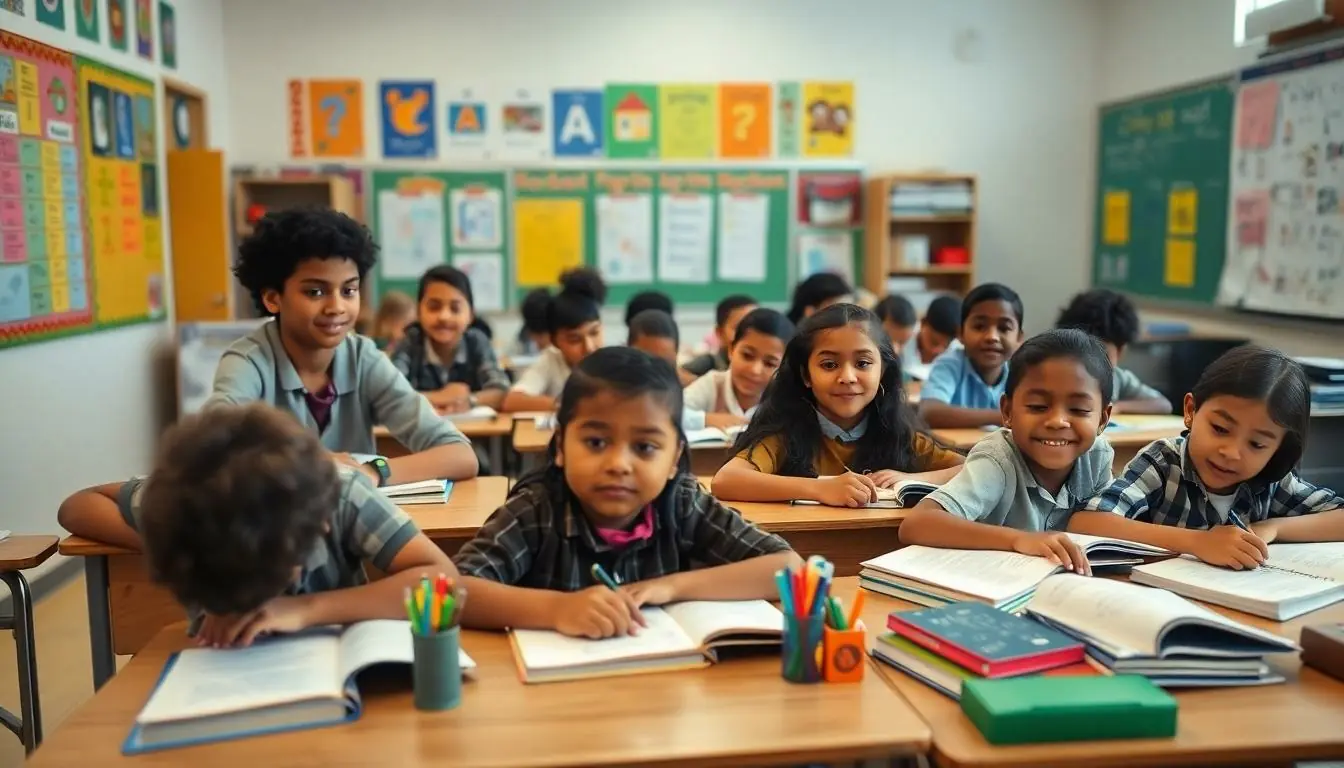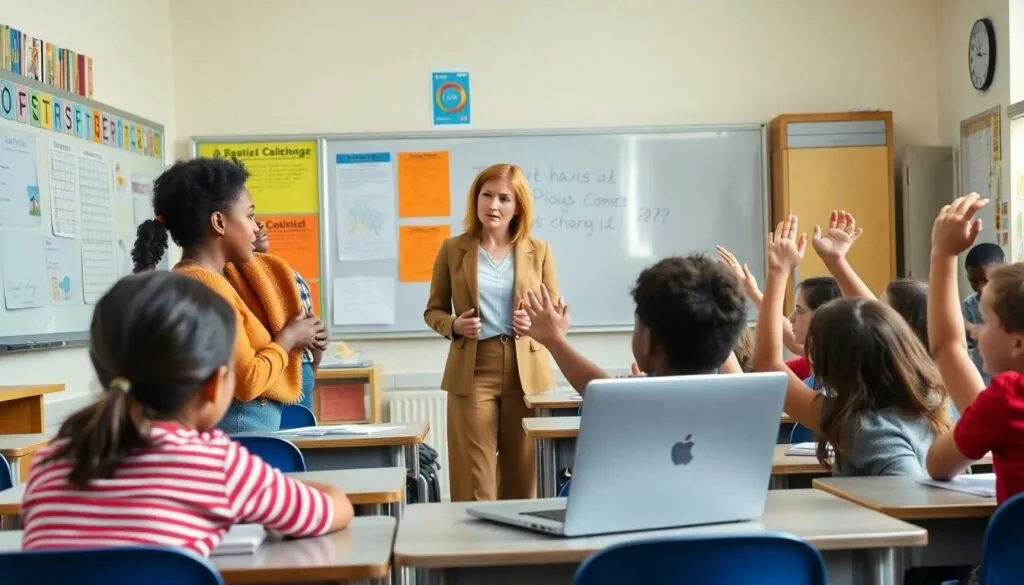Education today faces a whirlwind of challenges that make navigating the system feel like a game of dodgeball—except the balls are made of student loan debt, outdated curricula, and teacher burnout. As society evolves, so do the expectations placed on schools, teachers, and students. It’s a complex landscape where the stakes are high, and the solutions often seem as elusive as a Wi-Fi signal in a basement.
From the digital divide that leaves some students in the dark to the pressure cooker of standardized testing, these issues aren’t just buzzwords; they’re the reality shaping the future of learning. Understanding these challenges is crucial for anyone invested in the next generation’s success. Buckle up as we dive into the major issues in education today and explore what’s really at stake for students and educators alike.
Table of Contents
ToggleOverview of Major Issues in Education Today
Student loan debt represents a significant burden, affecting graduates’ financial stability. Outdated curricula hinder students’ ability to engage with relevant skills. Teacher burnout remains a pressing issue, stemming from increased workloads and emotional stress. Expectations surrounding education continue to evolve, complicating school environments further.
The digital divide affects access to technology, leaving some students at a disadvantage. Standardized testing adds pressure to both students and teachers, often overshadowing meaningful learning. Mental health challenges rise, impacting students’ overall well-being and performance in academic settings.
Funding disparities across districts create inequities in resources and opportunities. Changes in curriculum demand adaptation, but many educators lack sufficient training. Parental involvement often fluctuates, significantly influencing student success. Each of these factors intertwines, creating a complex challenge for the educational landscape.
Equitable access to quality education stands as a vital goal. Supporting schools with comprehensive resources can help address these ongoing issues. Addressing these challenges requires collaboration among educators, policymakers, and communities. Together, they can create a more equitable and effective education system.
Funding and Resource Allocation

Funding and resource allocation represent critical issues impacting education today. Disparities in funding contribute to unequal experiences for students across districts.
Disparities in Funding
Funding disparities exist between affluent and low-income districts. Wealthier areas often access more financial resources, leading to enhanced educational opportunities. Title I programs aim to address this inequity, yet gaps persist. In 2020, federal funding per student in high-poverty districts averaged $12,000, compared to $17,000 in wealthier districts. Schools in lower-income areas struggle with inadequate facilities, outdated materials, and fewer extracurricular activities. Consequently, students from disadvantaged backgrounds face significant barriers to success.
Impact on School Quality
School quality directly correlates with funding levels. Higher funding typically translates to better facilities, access to advanced technology, and more extracurricular programs. Research shows that schools receiving adequate funding often employ better-qualified teachers, leading to improved student outcomes. A National Bureau of Economic Research study found that increasing per-student funding by 10% results in higher graduation rates. Conversely, schools with limited resources often experience overcrowded classrooms and an inability to attract qualified educators, thus hindering student performance. Access to quality education becomes a challenge when funding varies so widely among districts.
Curriculum and Standardization
Standardized testing and relevant curriculum content represent significant issues within today’s education system. Both aspects greatly influence student engagement and learning outcomes.
Challenges with Standardized Testing
Test pressure frequently overshadows meaningful learning. Educators often face challenges in striking a balance between curriculum coverage and test preparation. Standardized tests measure students’ performance in limited subject areas, often neglecting critical skills like creativity and critical thinking. The focus on high-stakes testing can lead to teaching to the test, which diminishes the depth of education. Additionally, assessments may not accurately reflect diverse learning styles or cultural backgrounds. As a result, this leads to disparities in performance among students, creating inequities in educational opportunities.
Relevance of Curriculum Content
Curriculum relevance remains crucial for student engagement. Outdated content fails to address current societal needs and vital skills. In many instances, curricula do not incorporate modern technology or real-world applications, leaving students unprepared for future challenges. Incorporating subjects like financial literacy and mental health awareness can enhance educational experiences. An updated curriculum considers diverse perspectives and fosters inclusivity. As students express a greater interest in learning relevant material, schools must prioritize contemporary issues to cultivate lifelong learners. Relevance in curriculum ultimately supports students in achieving academic success and personal growth.
Teacher Support and Retention
Teacher support and retention are crucial for maintaining an effective education system. High levels of dissatisfaction and burnout significantly impact teacher retention rates.
Teacher Burnout
Teacher burnout affects job performance and student outcomes. Many educators experience emotional exhaustion due to heavy workloads and constant pressure. Factors contributing to burnout include increased administrative tasks and limited resources. Studies show nearly 50% of teachers leave the profession within their first five years. This trend highlights the urgent need for targeted support and resources to address the well-being of teachers. Establishing mentoring programs can provide new teachers with guidance and build a supportive network, promoting sustained commitment to their roles.
Lack of Professional Development
Professional development opportunities are often insufficient, limiting teacher growth. Many educators express a desire for training that aligns with classroom realities and addresses contemporary challenges. Research indicates that around 70% of teachers report feeling unprepared for effectively integrating technology into their classrooms. Customized workshops focusing on current trends can build teachers’ confidence and skills. Schools that invest in ongoing professional development create environments where educators thrive. Through collaboration and skill enhancement, teachers can implement innovative strategies, ultimately enriching the educational experience for students.
Technology Integration
Technology integration poses both challenges and opportunities in educational settings. Access to devices and the internet is critical for learning but remains uneven.
Access to Technology
Access to technology impacts students’ ability to engage with educational content. Many schools provide devices like laptops or tablets, yet not all students have the same access at home. About 20% of U.S. households lack reliable internet connections. This digital gap creates barriers in completing assignments, participating in online classes, and developing essential tech skills. Schools may implement programs to lend devices, but these solutions often fall short in addressing home internet access. Strategies such as leveraging community resources and partnerships can bridge these gaps, ensuring students interact with technology effectively.
Digital Divide
The digital divide highlights significant inequities in educational access and success. Wealthier districts typically enjoy advanced technological resources, while underfunded schools struggle with outdated equipment and limited internet access. Nearly 40% of low-income families report insufficient technology for remote learning. This disparity not only affects homework completion but also limits exposure to digital literacy and critical 21st-century skills. Policymakers must prioritize investing in infrastructure to enhance access in underserved communities. By addressing these gaps, educators can create a more equitable learning environment.
Student Mental Health and Wellbeing
Student mental health and wellbeing represent critical concerns in today’s education system. Rising mental health issues impact academic performance and overall student experience.
Increasing Mental Health Issues
Students face increasing mental health challenges due to factors like pressure from standardized testing and social media. According to studies, approximately 1 in 5 students experience mental health issues, including anxiety and depression. These problems often manifest in diminished academic performance and decreased engagement in school activities. Schools must address mental health by prioritizing awareness and resources. Early intervention can significantly impact students’ wellbeing, promoting resilience and supportive environments.
Support Systems in Schools
Support systems play a vital role in student wellbeing. Comprehensive mental health programs in schools can provide essential resources. Many schools are introducing counselors and mental health awareness programs to assist students. Peer support groups foster a sense of community, encouraging students to share their experiences. Moreover, training teachers to recognize mental health issues can lead to timely interventions. Investing in mental health resources generates a supportive atmosphere, ultimately enhancing student success.
Addressing the major issues in education today requires a collective effort from educators, policymakers, and communities. The challenges of student loan debt, outdated curricula, and teacher burnout cannot be overlooked. Equitable access to technology and resources is essential for leveling the playing field for all students.
Moreover, prioritizing mental health and well-being is crucial for fostering a supportive learning environment. By recognizing these challenges and advocating for necessary changes, stakeholders can work towards a more effective and inclusive education system. The future of education hinges on collaboration and commitment to ensuring every student has the opportunity to succeed.





